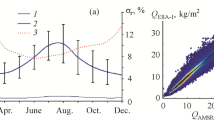Abstract
Water vapor in the earth′s upper atmosphere plays a crucial role in the radiative balance, hydrological process, and climate change. Based on the latest moderate-resolution imaging spectroradiometer (MODIS) data, this study probes the spatio-temporal variations of global water vapor content in the past decade. It is found that overall the global water vapor content declined from 2003 to 2012 (slope b = –0.0149, R = 0.893, P = 0.0005). The decreasing trend over the ocean surface (b = –0.0170, R = 0.908, P = 0.0003) is more explicit than that over terrestrial surface (b = –0.0100, R = 0.782, P = 0.0070), more significant over the Northern Hemisphere (b = –0.0175, R = 0.923, P = 0.0001) than that over the Southern Hemisphere (b = –0.0123, R = 0.826, P = 0.0030). In addition, the analytical results indicate that water vapor content are decreasing obviously between latitude of 36°N and 36°S (b = 0.0224, R = 0.892, P = 0.0005), especially between latitude of 0°N and 36°N (b = 0.0263, R = 0.931, P = 0.0001), while the water vapor concentrations are increasing slightly in the Arctic regions (b = 0.0028, R = 0.612, P = 0.0590). The decreasing and spatial variation of water vapor content regulates the effects of carbon dioxide which is the main reason of the trend in global surface temperatures becoming nearly flat since the late 1990s. The spatio-temporal variations of water vapor content also affect the growth and spatial distribution of global vegetation which also regulates the global surface temperature change, and the climate change is mainly caused by the earth’s orbit position in the solar and galaxy system. A big data model based on gravitational-magmatic change with the solar or the galactic system is proposed to be built for analyzing how the earth’s orbit position in the solar and galaxy system affects spatio-temporal variations of global water vapor content, vegetation and temperature at large spatio-temporal scale. This comprehensive examination of water vapor changes promises a holistic understanding of the global climate change and potential underlying mechanisms.
Similar content being viewed by others
References
Cess R D, 1989. Gauging water vapour feedback. Nature, 342: 736–737. doi: 10.1038/342736a0
Dessler A E, Schoeberl M R, Wang T et al., 2012. Stratospheric water vapor feedback. Proceedings of the National Academy of Sciences of the United States of America, 110: 18087–18091. doi: 10.1073/pnas.1310344110
Easterling D R, Wehner M F., 2009. Is the climate warming or cooling? Geophysical Research Letters, 36: L08706. doi: 10.1029/2009GL037810
Hubanks P A, King M D, Plantnick S et al., 2008. MODIS Algorithm Theoretical Basis Document No. ATBD-MOD-30 for Level-3 Global Gridded Atmosphere Products (08_D3, 08_E3, 08_M3). Collection 005 Version 1.1, 4 December 2008, 1–96.
King M D, Kaufman Y J, Menzel W P et al., 1992. Remote sensing of cloud, aerosol, and water vapor properties from the moderate resolution imaging spectrometer (MODIS). IEEE Transactions on Geosciences and Remote Sensing, 30(1): 2–27. doi: 0196-2892/92
Mao K B, Li Z, Chen J M et al., 2016a. Global vegetation change analysis based on MODIS data in recent twelve years. High Technology Letters, 22(4). (in press)
Mao K B, Ma Y, Tan X L et al., 2016b. Global surface temperature change analysis based on MODIS data in recent twelve years. Advances in Space Research. doi: 10.1016/j.asr.2016.11.007. (in press)
Mao K B, Ma Y, Xu T R et al., 2015. A new perspective about climate change. Scientific Journal of Earth Science, 5(1): 12–17.
Mao K B, Ma Y, Zuo Z Y et al., 2016c. Global water vapor content and vegetation change analysis based on remote sensing data. International Geoscience and Remote Sensing Symposium, 16: 5205–5208.
Mao K B, Ma Y, Zuo Z Y et al., 2016d. Which year is the hottest or coldest from 2001–2012 based on remote sensing data. International Geoscience and Remote Sensing Symposium, 16: 5213–5216.
Mao Kebiao, Wang Daolong, Li Zirui et al., 2009. A neural network method for retrieving land surface temperature from AMSR-E data. High Technology Letters, 19(11): 1195–1200. (in Chinese)
Rahmstorf S, Coumou D, 2011. Increase of extreme events in a warming world. Proceedings of the National Academy of Sciences of the United States of America, 108: 17905–17909. doi: 10.1073/pnas.1101766
Raval A, Ramanathan V, 1989. Observational determination of the greenhouse effect. Nature, 342: 758–761. doi: 10.1038/342758a0
Ravishankara A R, 2012. Water vapor in the lower stratosphere. Science, 337: 809–810. doi: 10.1126/science.1227004
Solomon S, Qin D, Manning M et al, 2007. Climate Change 2007: The Physical Science Basis. Contribution of Working Group I to the Fourth Assessment Report of the Intergovernmental Panel on Climate Change. Cambridge: Cambridge University Press, 1–50.
Solomon S, Rosenlof K H, Robert W P et al., 2010. Contributions of stratospheric water vapor to decadal changes in the rate of global warming. Science, 327: 1219–1223. doi: 10.1126/science.1182488
Author information
Authors and Affiliations
Corresponding author
Additional information
Foundation item: Under the auspices of National Key Research and Development Program (No. 2016YFC0500203), National Natural Science Foundation of China (No. 41571427)
Rights and permissions
About this article
Cite this article
Mao, K., Chen, J., Li, Z. et al. Global water vapor content decreases from 2003 to 2012: An analysis based on MODIS data. Chin. Geogr. Sci. 27, 1–7 (2017). https://doi.org/10.1007/s11769-017-0841-6
Received:
Accepted:
Published:
Issue Date:
DOI: https://doi.org/10.1007/s11769-017-0841-6



